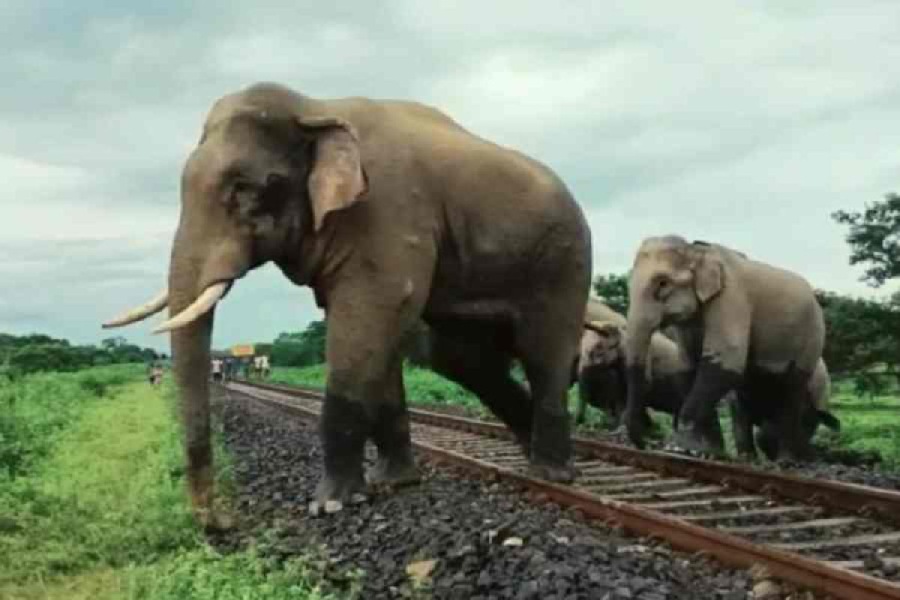The forest department of Bengal has decided to tag wild elephants with radio collars to avoid human-elephant conflict that has been steadily growing in the state for the past few years.
The proposal was mooted after chief minister Mamata Banerjee asked the forest department to initiate steps to prevent elephants from straying into human habitations, which has become a headache for the state government.
In 2024, at least 11 persons were killed and crops of a few hundred acres destroyed after elephants strayed into the villages located near the jungle areas across Bengal.
Because of human-elephant conflict, families are ravaged, the state government has to compensate victims and in the long run, people in elephant-prone zones start thinking of elephants as enemies, which endangers the safety of elephants.
“After the chief minister instructed the forest department to initiate measures to avoid human-elephant conflict, a detailed plan has been prepared. According to the plan, several initiatives, including the radio-collaring of elephants have been proposed. The detailed plan would be sent to Nabanna for required approval next week,” said a senior government official.
Sources in the forest department said that Bengal currently has about 800 elephants.
As elephants move around in herds of 10-12, the primary plan is to radio-collar at least one elephant in the herd.
“A total of 75-80 radio collars would be required to complete the project. It would not be a very costly affair as these days indigenous radio collars are available in the market at ₹1.5 lakh to ₹2 lakh each," said a senior forest official.
'Previously each radio collar used to cost between ₹15 lakh and ₹20 lakh,” he added.
The official said that once the elephants were collared, the forest department would be able to track the herd of elephants throughout the year.
In case any from the herd comes closer to the locality, the forest officials can rush to the spot and make the villagers aware of the situation.
Moreover, the forest officers can initiate measures to push back the elephants away from the locality.
The radio-collaring process is to put a collar with an attached radio transmitter on the neck of animals. Once the radio collaring is done, the animal can be monitored remotely in its natural habitat.
Forest officials said that the tracking of Odisha's tigress Zeenat in Bengal across the districts of Jhargram, Purulia and Bankura was a revelation.
Zeenat wore a radio collar.
“The tigress Zeenat, who had entered the jungles of Bengal from Odisha, could be tracked as she was radio-collared. There was no incident of human-tigress conflict," said a senior forester.
"Even though Zeenat had hunted some goats of the villagers in Purulia and Bankura, the forest officials reached the villages near which the tigress was located by tracking her through her radio collar,” he said. "Her radio collar, in effect, prevented the tigress from being harmed as well as villagers from coming too close."
"Radio collars would work similarly once the elephants are radio-collared," he said.
The department is eager to complete the task within the next three months.
It has decided to send a team of officials to Karnataka to get to know how elephants have been radio-collared in the southern state.
Not only radio-collaring the elephants across the state, the state government has a special plan for the elephants in north Bengal where the forests are more dense and human-elephant conflict is reported more frequently.
The department has identified seven corridors through which the elephants move around.
The department also plans to put up fencing along these corridors and grow vegetation in the corridor so that elephants have enough fodder and do not need to stray into the nearby villages and hamlets.
“According to the proposal, fencing would be put on the corridors. Each will be about 400 metres wide and 5-7km long. They will prevent elephants from entering into localities. A drive would also be taken to grow more vegetation on the elephant corridors so that they have enough to eat,” said another official.
In addition, the forest department would take up a massive awareness programme in villages and hamlets near the elephant corridors to avoid jumbo-human conflict.
“It has been noticed that some people go to the jungle in an intoxicated state and are attacked by elephants. An awareness programme would prevent these cases,” said a source.











